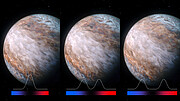Press Release
Extreme supersonic winds measured on planet outside our Solar System
21 January 2025
Astronomers have discovered extremely powerful winds pummeling the equator of WASP-127b, a giant exoplanet. Reaching speeds up to 33 000 km/h, the winds make up the fastest jetstream of its kind ever measured on a planet. The discovery was made using the European Southern Observatory’s Very Large Telescope (ESO’s VLT) in Chile and provides unique insights into the weather patterns of a distant world.
Tornados, cyclones and hurricanes wreak havoc on Earth, but scientists have now detected planetary winds on an entirely different scale, far outside the Solar System. Ever since its discovery in 2016, astronomers have been investigating the weather on WASP-127b, a giant gas planet located over 500 light-years from Earth. The planet is slightly larger than Jupiter, but has only a fraction of its mass, making it ‘puffy’. An international team of astronomers have now made an unexpected discovery: supersonic winds are raging on the planet.
“Part of the atmosphere of this planet is moving towards us at a high velocity while another part is moving away from us at the same speed,” says Lisa Nortmann, a scientist at the University of Göttingen, Germany, and lead author of the study. “This signal shows us that there is a very fast, supersonic, jet wind around the planet’s equator.”
At 9 km per second (which is close to a whopping 33 000 km/h), the jet winds move at nearly six times the speed at which the planet rotates [1]. “This is something we haven’t seen before,” says Nortmann. It is the fastest wind ever measured in a jetstream that goes around a planet. In comparison, the fastest wind ever measured in the Solar System was found on Neptune, moving at ‘only’ 0.5 km per second (1800 km/h).
The team, whose research was published today in Astronomy & Astrophysics, mapped the weather and make-up of WASP-127b using the CRIRES+ instrument on ESO’s VLT. By measuring how the light of the host star travels through the planet's upper atmosphere, they managed to trace its composition. Their results confirm the presence of water vapour and carbon monoxide molecules in the planet’s atmosphere. But when the team tracked the speed of this material in the atmosphere, they observed — much to their surprise — a double peak, indicating that one side of the atmosphere is moving towards us and the other away from us at high speed. The researchers conclude that powerful jetstream winds around the equator would explain this unexpected result.
Further building up their weather map, the team also found that the poles are cooler than the rest of the planet. There is also a slight temperature difference between the morning and evening sides of WASP-127b. “This shows that the planet has complex weather patterns just like Earth and other planets of our own System,” adds Fei Yan, a co-author of the study and a professor at the University of Science and Technology of China.
The field of exoplanet research is rapidly advancing. Up until a few years ago, astronomers could measure only the mass and the radius of planets outside the Solar System. Today, telescopes like ESO’s VLT already allow scientists to map the weather on these distant worlds and analyse their atmospheres. “Understanding the dynamics of these exoplanets helps us explore mechanisms such as heat redistribution and chemical processes, improving our understanding of planet formation and potentially shedding light on the origins of our own Solar System,” says David Cont from the Ludwig Maximilian University of Munich, Germany, and a co-author of the paper.
Interestingly, at present, studies like this can only be done by ground-based observatories, as the instruments currently on space telescopes do not have the necessary velocity precision. ESO’s Extremely Large Telescope — which is under construction close to the VLT in Chile — and its ANDES instrument will allow researchers to delve even deeper into the weather patterns on far-away planets. “This means that we can likely resolve even finer details of the wind patterns and expand this research to smaller, rocky planets,” Nortmann concludes.
Notes
[1] While the team hasn’t measured the rotation speed of the planet directly, they expect WASP-127b to be tidally locked, meaning the planet takes as long to rotate around its own axis as it does to orbit the star. Knowing how big the planet is and how long it takes to orbit its star, they can infer how fast it's rotating.
More information
This research was presented in the paper, "CRIRES+ transmission spectroscopy of WASP-127b. Detection of the resolved signatures of a supersonic equatorial jet and cool poles in a hot planet", published today in Astronomy & Astrophysics (doi: 10.1051/0004-6361/202450438).
The team is composed of L. Nortmann (Institut für Astrophysik und Geophysik, Georg-August-Universität, Göttingen, Germany [IAG]), F. Lesjak (IAG), F. Yan (Department of Astronomy, University of Science and Technology of China, Hefei, China), D. Cont (Universitäts-Sternwarte, Fakultät für Physik, Ludwig-Maximilians-Universität München, Germany; Exzellenzcluster Origins, Garching, Germany), S. Czesla (Thüringer Landessternwarte Tautenburg, Germany [TLS]), A. Lavail (Institut de Recherche en Astrophysique et Planétologie, Université de Toulouse, France), A. D. Rains (Department of Physics and Astronomy, Uppsala University, Sweden [Uppsala University]), E. Nagel (IAG), L. Boldt-Christmas (Uppsala University), A. Hatzes (TLS), A. Reiners (IAG), N. Piskunov (Uppsala University), O. Kochukhov (Uppsala University), U.Heiter (Uppsala University), D. Shulyak (Instituto de Astrofísica de Andalucía, Glorieta de la Astronomía, Spain), M. Rengel (Max-Planck-Institut für Sonnensystemforschung, Göttingen, Germany), and U. Seemann (European Southern Observatory, Garching, Germany).
The European Southern Observatory (ESO) enables scientists worldwide to discover the secrets of the Universe for the benefit of all. We design, build and operate world-class observatories on the ground — which astronomers use to tackle exciting questions and spread the fascination of astronomy — and promote international collaboration for astronomy. Established as an intergovernmental organisation in 1962, today ESO is supported by 16 Member States (Austria, Belgium, Czechia, Denmark, France, Finland, Germany, Ireland, Italy, the Netherlands, Poland, Portugal, Spain, Sweden, Switzerland and the United Kingdom), along with the host state of Chile and with Australia as a Strategic Partner. ESO’s headquarters and its visitor centre and planetarium, the ESO Supernova, are located close to Munich in Germany, while the Chilean Atacama Desert, a marvellous place with unique conditions to observe the sky, hosts our telescopes. ESO operates three observing sites: La Silla, Paranal and Chajnantor. At Paranal, ESO operates the Very Large Telescope and its Very Large Telescope Interferometer, as well as survey telescopes such as VISTA. Also at Paranal ESO will host and operate the Cherenkov Telescope Array South, the world’s largest and most sensitive gamma-ray observatory. Together with international partners, ESO operates ALMA on Chajnantor, a facility that observes the skies in the millimetre and submillimetre range. At Cerro Armazones, near Paranal, we are building “the world’s biggest eye on the sky” — ESO’s Extremely Large Telescope. From our offices in Santiago, Chile we support our operations in the country and engage with Chilean partners and society.
Links
- Research paper
- Photos of the VLT
- Find out more about ESO's Extremely Large Telescope on our dedicated website and press kit
- For journalists: subscribe to receive our releases under embargo in your language
- For scientists: got a story? Pitch your research
- World's darkest and clearest skies at risk from industrial megaproject
Contacts
Lisa Nortmann
University of Göttingen
Göttingen, Germany
Cell: +49 1515 1195435
Email: lisa.nortmann@uni-goettingen.de
David Cont
Ludwig Maximilian University of Munich
Munich, Germany
Tel: +49 89 218 09 297
Email: david.cont@lmu.de
Fei Yan
University of Science and Technology of China
Hefei, China
Tel: +86 551 63601861
Email: yanfei@ustc.edu.cn
Bárbara Ferreira
ESO Media Manager
Garching bei München, Germany
Tel: +49 89 3200 6670
Cell: +49 151 241 664 00
Email: press@eso.org
About the Release
| Release No.: | eso2502 |
| Name: | WASP-127b |
| Type: | Milky Way : Star : Circumstellar Material : Planetary System |
| Facility: | Very Large Telescope |
| Science data: | 2025A&A...693A.213N |
Our use of Cookies
We use cookies that are essential for accessing our websites and using our services. We also use cookies to analyse, measure and improve our websites’ performance, to enable content sharing via social media and to display media content hosted on third-party platforms.
ESO Cookies Policy
The European Organisation for Astronomical Research in the Southern Hemisphere (ESO) is the pre-eminent intergovernmental science and technology organisation in astronomy. It carries out an ambitious programme focused on the design, construction and operation of powerful ground-based observing facilities for astronomy.
This Cookies Policy is intended to provide clarity by outlining the cookies used on the ESO public websites, their functions, the options you have for controlling them, and the ways you can contact us for additional details.
What are cookies?
Cookies are small pieces of data stored on your device by websites you visit. They serve various purposes, such as remembering login credentials and preferences and enhance your browsing experience.
Categories of cookies we use
Essential cookies (always active): These cookies are strictly necessary for the proper functioning of our website. Without these cookies, the website cannot operate correctly, and certain services, such as logging in or accessing secure areas, may not be available; because they are essential for the website’s operation, they cannot be disabled.
Functional Cookies: These cookies enhance your browsing experience by enabling additional features and personalization, such as remembering your preferences and settings. While not strictly necessary for the website to function, they improve usability and convenience; these cookies are only placed if you provide your consent.
Analytics cookies: These cookies collect information about how visitors interact with our website, such as which pages are visited most often and how users navigate the site. This data helps us improve website performance, optimize content, and enhance the user experience; these cookies are only placed if you provide your consent. We use the following analytics cookies.
Matomo Cookies:
This website uses Matomo (formerly Piwik), an open source software which enables the statistical analysis of website visits. Matomo uses cookies (text files) which are saved on your computer and which allow us to analyze how you use our website. The website user information generated by the cookies will only be saved on the servers of our IT Department. We use this information to analyze www.eso.org visits and to prepare reports on website activities. These data will not be disclosed to third parties.
On behalf of ESO, Matomo will use this information for the purpose of evaluating your use of the website, compiling reports on website activity and providing other services relating to website activity and internet usage.
Matomo cookies settings:
Additional Third-party cookies on ESO websites: some of our pages display content from external providers, e.g. YouTube.
Such third-party services are outside of ESO control and may, at any time, change their terms of service, use of cookies, etc.
YouTube: Some videos on the ESO website are embedded from ESO’s official YouTube channel. We have enabled YouTube’s privacy-enhanced mode, meaning that no cookies are set unless the user actively clicks on the video to play it. Additionally, in this mode, YouTube does not store any personally identifiable cookie data for embedded video playbacks. For more details, please refer to YouTube’s embedding videos information page.
Cookies can also be classified based on the following elements.
Regarding the domain, there are:
- First-party cookies, set by the website you are currently visiting. They are stored by the same domain that you are browsing and are used to enhance your experience on that site;
- Third-party cookies, set by a domain other than the one you are currently visiting.
As for their duration, cookies can be:
- Browser-session cookies, which are deleted when the user closes the browser;
- Stored cookies, which stay on the user's device for a predetermined period of time.
How to manage cookies
Cookie settings: You can modify your cookie choices for the ESO webpages at any time by clicking on the link Cookie settings at the bottom of any page.
In your browser: If you wish to delete cookies or instruct your browser to delete or block cookies by default, please visit the help pages of your browser:
Please be aware that if you delete or decline cookies, certain functionalities of our website may be not be available and your browsing experience may be affected.
You can set most browsers to prevent any cookies being placed on your device, but you may then have to manually adjust some preferences every time you visit a site/page. And some services and functionalities may not work properly at all (e.g. profile logging-in, shop check out).
Updates to the ESO Cookies Policy
The ESO Cookies Policy may be subject to future updates, which will be made available on this page.
Additional information
For any queries related to cookies, please contact: pdprATesoDOTorg.
As ESO public webpages are managed by our Department of Communication, your questions will be dealt with the support of the said Department.





